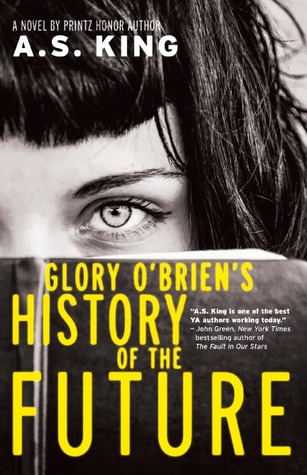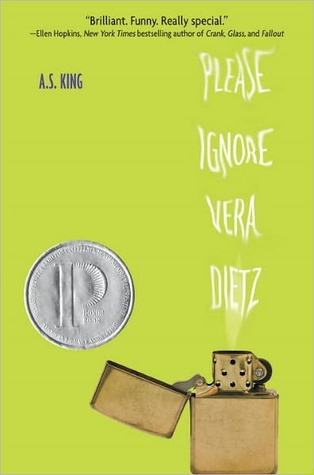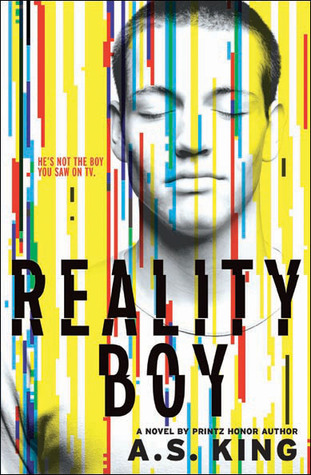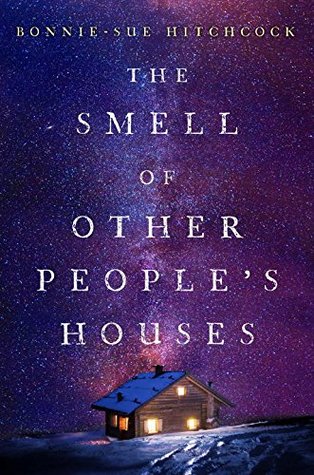King, A. S. (2010). Please ignore Vera Dietz. NY: Alfred A. Knopf.
8. Requirement Met - Author A.S. King
Summary - Vera Dietz has been taught to ignore. Ignore the abuse going on next door, ignore that her mother has left her and her dad, ignore that life can be difficult. When her best friend Charlie dies, she is left to struggle with the loss of their friendship, his death and the fact that people believe he died a criminal. The problem is Charlie is not letting her ignore any of those things. As Vera starts her senior year of high school she struggles with her alcoholic genes, her desperate need for friendship, her full time work and school schedule, and her crush on her 23 year old coworker. Occasionally we hear from Vera's dad, from Charlie, and from the town landmark but most of the story is told from Vera's mature and cynical perspective with a series of flashbacks. Despite the inconsistent timeline, the plot and suspense builds and captivates as Vera comes to terms with the fact that she will have to forgive Charlie in order to clear his name.

My take - King takes her time to tell this story, sometime belaboring the details of events. There is more explanation of pizza prep and delivery than was needed, but it does paint a picture of the repetition in Vera's daily life. Charlie is quite the complex character and is still a mystery to me, and to Vera as well. This is no light-hearted high school novel about friends or death. It is deep and asks some honest questions about what is both accepted and ignored in modern-day America.
Textbook tie-in - I would consider this book Young Adult and contemporary realistic fiction. The main character is highly independent and must make the decision whether or not to clear her friend's name. The story takes place is less than a year and we see Vera grow and move in a positive direction.
Themes Other Books by A.S. King
Loss and Abandonment.
Drugs and Alcohol
Choices
Duty
Coming of age
--------------------------------------------------------------------------------------------------------
Quintero, I. (2014). Gabi: A girl in pieces. TX: Cinco Puntos
7. Requirement met: Required book
Summary - Gabi Hernandez has a lot on her mind during her senior year of high school. Her best friend Cindy just found out that she is pregnant, her other best friend Sebastian just told her that he is gay, her father is addicted to meth, and she wants more than anything to go to college to make something of herself. Readers are offered a glimpse into Gabi's world through her senior year journal that is filled with her honest thoughts, feelings, insecurities, and impressive poetry. Oh, and she has a lot to say about food!
Gabi's writing is captivating and her take on life, parents, boys and sex is raw, hilarious and endearing. Reading her account of finding her dad's body in the garage after he overdosed was devastating. I couldn't help but root for her success because her parents certainly didn't do anything to benefit or help her. She is a strong character who doesn't know her own strength and I have found myself thinking about her since I finished the book. I've wondered how she's doing in college, are she and Martin still together, or did her mom ever come to terms with Gabi leaving home? Isabel Quintero offered a great voice to this character who taught me about life in America as a Mexican girl, torn between family, religion, and two cultures.
Teaching Ideas - it would be difficult to use this in a classroom given the subject matter and the way it is discussed. The poetry used throughout the book is inspiring and made me wish I had an outlet for teaching poetry to teenagers. Poems used include: Haikus that reflect life events, Shakespeare's Sonnet 130, A Red, Red Rose by Robert Burns, and Lady Lazarus by Sylvia Plath.
Textbook Tie-in - There are so many vicarious experiences that readers can benefit from in this book. Seeing the realities of teen pregnancy and drug use through Gabi's eyes are so compelling and raw. She doesn't glamorize the difficulties and learning through her could benefit any teen.
--------------------------------------------------------------------------------------------------------
Green, J, (2006). An abundance of Katherines. New York, New York: Penguin Group.
6. Requirement met: Author John Green
Summary - Colin Singleton was a child prodigy who just graduated from high school and was dumped by his girlfriend Katherine. She was known as Katherine XIX, as she was the nineteenth girl named Katherine that dated then dumped him. Colin and his best friend Hasaan embark on a road trip to wherever to help Colin deal with the heartache he feels about his loss of Katherine and the status as a child prodigy. He feels his genius won't translate to adulthood so he attempts to create a formula that will predict the pattern and outcome of relationships. Along the way, they find themselves in small town Tennessee where they meet a wealthy business woman, Hollis and her daughter, Lindsey Lee. Soon Colin and Hasaan have a job recording the history of the town as told by its oldest residents. This novel is about self discovery, which for Hasaan prompts him to finally sign up for college classes and for Colin, to break the cycle of being dumped by Katherines when he falls for Lindsey Lee Wells.
My take - This is my first John Green novel and I purposely chose one that hasn't been turned into a movie. The bizarre premise of this story was hard for me to accept. Nineteen girlfriends named Katherine. Why 19? This one piece of the plot really hampered my acceptance of Colin, yet the secondary characters were much more interesting and convincing. I never found myself rooting for Colin because he was hard to like. His mind works so differently than mine, that it was hard to connect to him. Although, this may have been done intentionally by Green.
Extensions - Anagrams and mathematical formulas play a large part in how Colin's mind works and how he copes with loss or new situations. This strategy for evaluating situations or story elements would make for an interesting new way to look at literature. While I can't recommend this book for classroom assignments, it does offer a unique example of a coming-of-age tale.
Textbook tie-in - When looking over all the benefits gained from reading YA novels, I cannot relate any of them to this book. I certainly didn't see myself in this book, or gain empathy or any cultural awareness. I do find it interesting that the protagonist is not particularly independent like is common in YA novels.
--------------------------------------------------------------------------------------------------------
Alexie, S. (2007). The absolutely true diary of a part-time Indian. NY: Little, Brown and Company.
5. Requirement met: Required book
Summary - Junior is struggling to find his place in the world. He wants to honor his family and his heritage by remaining true to his life on the reservation, but he knows there is no hope there. He knows his only way out is to attend the white school 22 miles from home, but at what cost? His best friend has turned his back on him and life at home on the reservation is even harder than usual. Now that he's made the change, everyone in his tribe hates him for acting white and everyone at his new school hates "the new Indian kid." Junior holds nothing back in his diary entries as he shares his loneliness and eventually grief, as he loses both his grandmother and sister suddenly. He is the undeserving victim of alcoholism, racism, and a hopeless future.
"If you let people into your life a little bit, they can be pretty damn amazing."
My take - I went into this story with no idea what life on an Indian reservation is like. The stories of poverty and desperation were both compelling and sad. Since this is semi-autobiographical, I sought to read about Sherman Alexie's life in the hopes that I would have some understanding about that happens to Junior. He is so torn between his culture and his future. When Rowdy validated Junior's decision and gave him his blessing in his own way, this portion of Junior's story concluded in a perfect and satisfying way.
Extensions -
- The cultural discussions in this story would make for a great study of Native American life in modern America.
- The artwork does a great job of adding to the story without distracting from it.
- Racial tensions and differences discussed in Junior's experiences would be an interesting sociological study.
--------------------------------------------------------------------------------------------------------
4. Requirement met: Required Novel
 Summary - Monster tells the story of 16 year old Steve Harmon's experiences and feelings while in juvenile prison for his role in a neighborhood murder. Steve's recent study of movie-making in his film class at school serves as his coping device during his imprisonment and trial. Steve's fear of his prison mates is palpable and his reality is quite bleak. While the complexities of Steve's case is battled out by the prosecutor and defense attorneys, his future is in limbo. Written as a movie screenplay, the reader is allowed to see all around the courtroom while getting a glimpse into Steve's thoughts and fears. In the end, Steve's involvement in the robbery and murder are basically irrelevant and he is set free.
Summary - Monster tells the story of 16 year old Steve Harmon's experiences and feelings while in juvenile prison for his role in a neighborhood murder. Steve's recent study of movie-making in his film class at school serves as his coping device during his imprisonment and trial. Steve's fear of his prison mates is palpable and his reality is quite bleak. While the complexities of Steve's case is battled out by the prosecutor and defense attorneys, his future is in limbo. Written as a movie screenplay, the reader is allowed to see all around the courtroom while getting a glimpse into Steve's thoughts and fears. In the end, Steve's involvement in the robbery and murder are basically irrelevant and he is set free.My take - Steve was a sympathetic character and I found myself rooting for him, despite not really knowing his involvement in the crime. Myers paints quite a picture of desperation. Steve is seen as a monster by everyone in the courtroom but he knows that does not define him. As I read this, I wondered how I would view Steve if I was on the jury or in the attorney's chair. The story made me question my own assumptions and views.
Extensions -
- Could be read in a film class as a study of how to write screenplays
- Could be studied in an high school introduction to law and allow students to use the facts of the case to determine a verdict.
--------------------------------------------------------------------------------------------------------
3. Requirement met: NY Times Bestseller May 2017
Summary - Pax was raised by his "boy," Peter and the two were inseparable. When Peter's father must go off to war, he forces Peter to abandon Pax in the woods while he is sent off to live with his grandpa. Peter is haunted by the thought of leaving Pax to fend for himself in the woods and is determined to take the long trek by foot to find him. Peter doesn't make it very far before breaking his leg and being forced to live with a strange lady in the woods. Meanwhile, Pax is beginning to learn how to take care of himself in the woods, but he refuses to leave the spot where his boy left him. He knows Peter will come back to find him. Peter and Pax both face dangers, hunger and certain death to find each other. When they finally do, Peter realizes that Pax is at home in the woods with his new pack and is forced to leave him again, This time, it's Peter's decision and he knows it is the best thing for Pax.
My take - After reading this book, I wanted to learn all I could about foxes. I've never really had much interest in them but Pennypacker's sweet story of a boy and his fox won my heart. Their loyalty to each other was amazing! The alternating narration offered such great perspective and I truly believed I was reading the thoughts of a fox. Both Peter and Pax take such unbelievable journeys to find each other and when they do, their reunion was sweet and sad at the same time. I truly love recommending this book to my 5th graders!
Extensions - Pax would make a great read aloud and study of "voice." Since each chapter alternates narrators, it really tells two stories. It would be interesting to story map the book as it is read aloud and watch as the two stories resolve as one.
Textbook Tie in - Peter is a young, independent protagonist who must make big decisions regarding whether to defy his father to find his fox. There are few other developed characters and Peter ultimately has to confront his father. While it fits all the YA characteristics, this book would make a great recommendation for that middle school group that wants more mature books but can't handle mature themes.
--------------------------------------------------------------------------------------------------------
Anderson, L. H. (1999). Speak. NY: Farrar Strauss Giroux.
2. Requirement met: required novel
Summary - Melinda has just begun her freshman year of high school and she is already a complete outcast. Through Melinda's perspective, we see the harsh realities of high school drama and injustice. The trauma she suffered at the end of summer has left her almost mute and neither her friends nor her parents seem to care what has brought on this sudden change in her personality. She literally bites wounds in her mouth to keep from speaking and her desperation is difficult to watch. Through art class, she finds an outlet for exploring her emotions and eventually discovers her voice with graffiti on a bathroom wall. When other girls validate her words, her confidence grows and she begins to feel hopeful. The safe haven she has created in the midst of her oppressive school becomes the place where she is eventually set free of her silent fear. As the novel resolves, the reader can't help but feel hopeful for Melinda as she has conquered her demon and found her voice.
My take - Anderson took me on a year long ride through the mind of a girl who has suffered unspeakable trauma. Melinda's isolation is difficult to imagine and I found myself pleading with the people around her to notice her pain. As a mother to a girl Melinda's age, I struggled to relate to Melinda's mother who seemed constantly annoyed by the presence of her teenage daughter. I just kept thinking what a horrible combination of parents and friends Melinda is stuck with! How sad that she found comfort in a stinky, janitor's closet or a hospital waiting room. It was so gratifying when she wrote out her story for Rachel to read. It didn't even matter that Rachel didn't believe her. When Ivy showed her the additional notes on the bathroom wall, I couldn't help but be relieved that Melinda was no longer alone in her silence or fear. Speak was a powerful story that I'm grateful to have read.
Extensions - I find it interesting that there is controversy surrounding this book, when comparing it to other books I have read from our list. While the subject matter is mature, it is told in a way that doesn't glorify or dwell on the crime. Melinda's struggles to cope are the focus of the novel and therefore one that I think should be widely read amongst high school students. Either you're like Melinda or you can learn empathy from her story. It will not leave you unchanged.
Textbook tie-in - What a great book to teach empathy! I almost feel all high school teachers should be required to read this book to understand the mind of the girl who is clearly suffering. Sadly, this book could also serve quite therapeutic for girls who are reading autobiographically. I think regardless of a reader's circumstances, this book can be a tool for learning and understanding.
--------------------------------------------------------------------------------------------------------
Hitchcock, B. (2016). The Smell of Other People's Houses. NY: Wendy Lamb Books.
1. Requirement Met: William C. Morris Finalist 2016
Summary - Ruth's idyllic life took a tragic turn when she was only five and now she is being raised by difficult grandmother in 1960's Alaska. Dora lives her life in fear that her father will get out of prison and find her living comfortably with her best friend's family. Alyce is torn between her love of dance and her loyalty to her father and his fishing business. Hank isn't sure what he's supposed to do as the "man of the family," but he knows he must rescue his brothers from mom's abusive boyfriend and their explosive relationship. Their unrelated stories bump and collide into each other with a mix of Alaska statehood struggles, race relations, fishing, poverty, family and friends who feel like family. Hitchcock creates four impressive stories of teenagers who are strong and brave despite their difficult circumstances. They learn about themselves while rescuing each other.
My take - Each story represents an endearing protagonist and even though the perspective changes often, I never minded. As the stories drew to a close and hinted at the conclusion to come, I hoped that their four stories would end as one. Hitchcock creates a satisfying, redemptive ending that was a beautiful as I hoped it would be. I loved these characters and this book!
Extensions - One of the beautiful features of this book is that it tells 4 different stories and weaves them together at their conclusion. This would be an interesting book to have students story map or create a timeline demonstrating the uniqueness of its series of events. With the setting of the story being Alaska in the early years of their statehood, this book would create great discussions on how the natives' lives were changed. Alaskan history plays an important role in the story and taught me that it wasn't a positive change for many Alaskans.
Textbook tie-in - For me, I got lost in this book while learning about life in Alaska. There were more well-developed characters in this book than in other YA novels. Each of the four main characters face huge decisions and grow throughout the story.








No comments:
Post a Comment